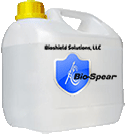Bio-Spear News Letters
03.01.2011
News Comments Home-washed surgical scrubs at greater contamination risk.
The study, carried out by Bioscience Laboratories in the US and sponsored by Molnlycke Health Care US, found that home-laundered scrubs cleaned and ready to wear had as many bacteria in them as facility-laundered, third-party laundered and single-use scrubs which had been worn for a day. A total of 80 surgical scrub garments, tops and bottoms were collected from multiple healthcare facilities across the US. There were 10 sets of scrubs in each category: single-use; home-laundered; facility-laundered and third-party laundered.
"According to these results, a healthcare professional beginning his or her shift in home-laundered scrubs would essentially be wearing scrubs with the same quantity of bacteria as the scrubs of a healthcare professional finishing a shift in worn scrubs," said Heather Beitz, director of clinical research for Molnlycke Health Care.
Source: Cleanroom Technology.
News Archive
- 15.11.2010 Triclosan Exposure Levels
Triclosan Exposure Levels Increasing in Humans
Levels of the chemical triclosan have increased in humans by an average of 50 percent since 2004, according to newly updated data from the Centers for Disease Control and Prevention (CDC). Meanwhile, a new study out of the University of Toledo has found that both triclosan and triclocarban can enter the food chain through of the use of contaminated wastewater or fertilizer in agricultural fields. Each of these findings on its own is troubling, but together they make the case for banning the two chemicals even stronger, according to health experts at the Natural Resources Defense Council (NRDC), a national, nonprofit organization of scientists, lawyers and environmental specialists dedicated to protecting public health and the environment.
Triclosan and triclocarban are found in consumer and personal care products, such as hand soap, labeled antibacterial or antimicrobial. But the two chemicals are suspected endocrine disruptors that can interfere with hormones needed for the brain and reproductive system to develop properly. The NRDC says that the Food and Drug Administration (FDA) has admitted that using hand soap containing these chemicals actually does not work any better than regular soap. Last week, the NRDC sued the FDA to force the agency to issue a final rule on the safety and effectiveness of the two chemicals that has been three decades in the making.
- 27.10.2010 EPA Acts on Petition
EPA Acts on Petition to Regulate Nano-Silver Products.
Acknowledging the critical need for in-depth review of products utilizing nanotechnology pesticides, the Environmental Protection Agency (EPA) opened a 60-day public comment period in response to a petition filed by the International Center forTechnology Assessment (ICTA), which demands the agency stop the sale of numerous consumer products with nano-silver.
In the Federal Registry notice released yesterday, EPA determined that ICTA's petition "raises serious issues that potentially affect private and public sector stakeholders" and is instituting a 60-day period for public comment. EPA will review the petition and any comments received "before deciding how best to respond to the petition."
- 02.09.2010 Silver Nanoparticles Stop Sperms
Silver Nanoparticles Stop Sperm Stem Cell Growth
A new study has identified exactly how silver nanoparticles cause male reproductive cells to stop growing.
Minute materials used in a number of consumer products such as antimicrobial agents can interrupt important cell signaling within male reproductive sperm cells, causing them to stop growing, according to a new study that builds on previous work by the same research group.
In prior studies, the scientists reported how smaller-sized silver nanoparticles – in the 10 – 25 nanometer range – decreased the growth of male stem cells when they were exposed at concentrations greater than 10 micrograms per milliliter (ug/ml).
The new study is the first to identify how the silver nanoparticles stop the sperm stem cells from growing. The biggest effects were caused by the smallest-sized nanoparticles tested.
- 31.08.2010 WHO urges countries to take measures
WHO urges countries to take measures to combat antimicrobial resistance.
20 AUGUST 2010 | GENEVA — Antimicrobial resistance (AMR) – the ability of micro-organisms to find ways to evade the action of the drugs used to cure the infections they cause – is increasingly recognised as a global public health issue which could hamper the control of many infectious diseases. Some bacteria have developed mechanisms which render them resistant to many of the antibiotics normally used for their treatment (multi-drug resistant bacteria), so pose particular difficulties, as there may be few or no alternative options for therapy. They constitute a growing and global public health problem.
WHO suggests that countries should be prepared to implement hospital infection control measures to limit the spread of multi-drug resistant strains and to reinforce national policy on prudent use of antibiotics, reducing the generation of antibiotic resistant bacteria.
- 30.08.2010 Antibacterial Household Products:
Antibacterial Household Products: Cause for Concern.
Presentation from the 2000 Emerging Infectious Diseases Conference in Atlanta, Georgia
Stuart B. Levy Tufts University School of Medicine, Boston, Massachusetts, USA
The recent entry of products containing antibacterial agents into healthy households has escalated from a few dozen products in the mid-1990s to more than 700 today. Antibacterial products were developed and have been successfully used to prevent transmission of disease-causing microorganisms among patients, particularly in hospitals. They are now being added to products used in healthy households, even though an added health benefit has not been demonstrated. Scientists are concerned that the antibacterial agents will select bacteria resistant to them and cross-resistant to antibiotics. Moreover, if they alter a person's microflora, they may negatively affect the normal maturation of the T helper cell response of the immune system to commensal flora antigens; this change could lead to a greater chance of allergies in children. As with antibiotics, prudent use of these products is urged. Their designated purpose is to protect vulnerable patients.
Antibiotics are critical to the treatment of bacterial infections. However, after years of overuse and misuse of these drugs, bacteria have developed antibiotic resistance, which has become a global health crisis (1, 2). The relatively recent increase of surface antibacterial agents or biocides into healthy households may contribute to the resistance problem.
- 23.07.2010 Drug Resistance – "Super" Bugs
Drug Resistance – "Super" Bugs July,18th,2010
Modern Medicine considers antibiotics to be one the greatest success stories of all time. Sir Alexander Fleming discovered penicillin 75 years ago. Antibiotics first became widely used in the World War II era. 50 years+ later, antibiotics are no longer as effective as they were perceived to be. Sir Alexander Fleming predicated this would happen 75 years ago.
Drug resistance happens when germs develop ways to survive the use of medicines meant to kill or weaken them. Yes, bacteria has found ways to outwit…
- 11.06.2010 German Institute Advises
German Institute Advises Against Using Nanoscale Silver Ions in Consumer Products.
The manufacturers of consumer products have made use of the antimicrobial properties of silver ions for some time now.
Recently, silver particles in the nanorange have likewise been used. For instance, the surfaces in fridges coated with nanosilver are intended to inhibit the growth of germs and nanosilver aims to prevent odour formation in sports socks. It is not possible at the present time to determine in a definitive manner whether nanosilver constitutes a health risk for consumers…
- 02.06.2010 USDA Detects Antimicrobial-Resistant
USDA Detects Antimicrobial-Resistant Genes by Helena Bottemiller
Using an advanced genetic screening technique, the U.S. Department of Agriculture's (USDA's) Agricultural Research Service scientists have detected–for the first time–over 700 genes that give microbes like Salmonella and E. coli the ability to resist antibiotics and other antimicrobial compounds…
- 14.07.2009 Popular Pesticide Triclosan Found
Popular Pesticide Triclosan Found to Carry Numerous Health and Environmental Risks
Food & Water Watch and Beyond Pesticides File Petition to FDA to Ban Triclosan for Non-Medical Uses.
WASHINGTON – July 14 – Food & Water Watch, a national consumer advocacy organization, in partnership with the public health and environmental activist group Beyond Pesticides, today submitted an amended petition to the United States Food and Drug Administration (FDA) requiring that the agency ban the use of the controversial pesticide triclosan for non-medical applications on the basis that those uses violate the Federal Food, Drug and Cosmetics Act. Strong scientific evidence suggests that pervasive use of triclosan poses imminent threats to human health and the environment.
"Numerous scientific studies and reports clearly indicate that in addition to its human health and environmental dangers, triclosan is not effective for many of its intended benefits and may actually be doing consumers more harm than good," said Wenonah Hauter, executive director of Food & Water Watch. "Even worse, is that current regulations on triclosan haven't been updated since 1994 and much of the science used by the FDA to regulate the pesticide dates back to the late 1970s and early 1980s. The agency's inconsideration of new scientific research on triclosan represents an egregious failure to properly protect the public against this dangerous pesticide."
Regulated by both the FDA and the United States Environmental Protection Agency (EPA), triclosan is commonly found in hand soaps, toothpastes, deodorants, laundry detergents, fabric softeners, facial tissues, antiseptics, fabrics, toys, and medical devices. Scientific studies indicate that widespread use of triclosan causes a number of serious health and environmental problems.
Chief among those issues is resistance to antibiotic medications and bacterial cleansers, a problem for all people, but especially vulnerable populations such as infants and the elderly. Triclosan is also a known endocrine disruptor and has been shown to affect male and female reproductive hormones, which could potentially increase risk for breast cancer. Further, the pesticide can also interact with other chemicals to form dioxin and chloroform, thereby exposing consumers to even more dangerous chemicals.
Due to the fact that many products containing triclosan are washed down the drain, triclosan also shows up in water systems and sewage sludge. Accumulation of the pesticide in waterways and soil has been shown to threaten ecosystems and produce hazardous residues in fish and food crops.
"Triclosan's growth to a nearly $1 billion consumer market is indicative of the failure of the FDA to regulate unnecessary, ineffective products that are toxic to both people and the environment," said Jay Feldman, executive director of Beyond Pesticides. "The marketing of triclosan preys on consumer fears regarding bacterial-born illness, despite the fact that scientific findings show triclosan to be no more effective than soap and water, and may actually cause more harm than good in advancing bacterial resistance."
EPA Registered
Groundbreaking patented  antimicrobial nanotechnology that works by not migrating or diffusing away from the substrate like nano silver.
antimicrobial nanotechnology that works by not migrating or diffusing away from the substrate like nano silver.


